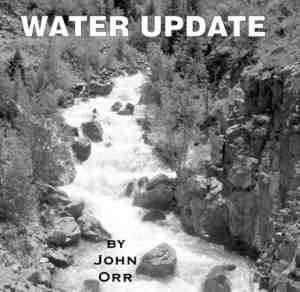Article by John Orr
Water – December 2008 – Colorado Central Magazine
RGWCD – Special Improvement District No. 1
The management plan for the Rio Grande Water Conservation District’s Special Improvement District (Subdistrict) No. 1 was on trial during late October and early November; and on December 16th, Division Three Water Court Judge O. John Kuenhold plans to hear closing arguments in the case.
The management plan — blessed by the district and the state engineer — is a first attempt at reducing pumping in the area north of the Rio Grande River known as the Closed Basin. The state argues that consumption has increased past the point where natural recharge can replenish the system and has led to declining water tables and loss of well productivity.

According to the management plan, “The reduced native water supply is the result of the onset of a serious and prolonged drought that has greatly reduced inflows and surface water diversions into the Subdistrict lands. In order to restore balance between available supplies and current levels of use it will be necessary to permanently reduce the number of acres irrigated in the Subdistrict by approximately 40,000.”
Earlier this year State Engineer Dick Wolfe told valley irrigators that it would be better for them to solve the problem before the state has to act. In 2007, the state shut down over 400 wells in the South Platte River Basin, and current rules could lead to involuntary shut downs in the San Luis Valley as well.
Objectors to the plan claim it is too vague and will not adequately compensate or protect surface irrigators who have been curtailed over the years to satisfy downstream obligations for Colorado under the Rio Grande Compact.
The Valley Courier reported that attorney Tim Buchanan — representing senior rights holders — said, “This plan will lay the groundwork for future plans,” and that it is a, “fundraising plan,” so, “don’t masquerade it around as a water management plan.” Objectors also maintained that the plan would not end curtailments and that the subdistrict would get a “pass” from subsequent rules and regulations for groundwater pumping.
But Deputy State Engineer Michael Sullivan said, “I do see the plan and procedures as workable.” He added that the plan is an attempt to, “stop the bleeding, so to speak.” Proponents of the plan contend that objectors will be able to go back to water court for relief if the plan does not yield the anticipated results.
Short takes
The Lincoln Park (Cotter Mill) superfund site was in the news again in October. State officials issued a “notice of violation” to Cotter with respect to a new plume of uranium tainted groundwater that was spreading toward the Arkansas River. The U.S. Department of Health and Human Services Agency for Toxic Substances and Disease Registry has launched a new study of the health effects stemming from pollution at the site.
The state of Colorado has created a new agency — the Colorado Conservation Easement Oversight Commission — in response to an investigation by the IRS and state Real Estate Division. Their audits have discovered numerous appraisal shenanigans related to the popular program. The oversight agency officially begins the work of certifying land trusts on January 1st.
Despite a dry summer in the San Luis Valley the state engineer’s office is forecasting a credit to Colorado under the Rio Grande Compact since the state produced overdeliveries this year.
You may have seen a helicopter with a long boom attached flying near the Great Sand Dunes National Park in late October. Researchers are using it to measure the magnetic properties of the rock formations in the area as part of the geophysical mapping of the San Luis Valley’s faults and their effect on groundwater flow.
The league of Conservation voters released their scores for Colorado legislators just in time for early voting in October. Representative Salazar scored 85; Doug Lamborn 0; Senator Salazar 100; and Senator Allard 18.
Voters in Pitkin County approved a one-tenth of one percent increase in sales tax on the fall ballot. Revenues from the increase — dubbed the Healthy Rivers and Streams Fund — will be used to obtain water to augment stream flows in the county.
Alamosa showed off its new treatment plant in late October. The plant was built to bring the city in compliance with arsenic standards. The new plant also allows the town to add chlorine to the supply for better disinfection.
Gunnison County is taking a hard look at further funding for cloud seeding efforts. The county is facing a tight budget. Last year’s record snowfall and subsequent plowing bill — and the draining of county coffers — are cited as reasons to stop the snowmaking effort.
Fairplay has agreed to supply treated water to the Red Hill Forest subdivision. The agreement calls for Red Hill to pay for the infrastructure required for delivery and does not involve a change of ownership of Fairplay water rights.
Over the summer, operators of the Summitville Mine Superfund Program spent $3 million upgrading the water system to withstand a hundred-year event. Projects included enlarging discharge culverts on the Wightman Fork Diversion, enlarging the impoundment dam, and upgrading portions of the infrastructure that direct water to the treatment plant.
Applications for the Colorado River District Large Grant Program are due by January 31, 2009. The grants provide financial assistance for projects that develop new water supplies within the district’s boundaries. For more information call 970-945-8522 or email grantinfo@crwcd.org.
Congratulations to Jerry Livengood for being named the 2008 Water Commissioner of the year for Division Two. Livengood is a life-long resident of the Wet Mountain Valley and for over 20 years was the plant supervisor for the Round Mountain Water and Sanitation District.
Habitat improvement work on three ponds in the Monarch Lake area is on hold pending a determination of evaporative loss and an augmentation plan. CDOT, the U.S. Forest Service and the Department of Wildlife have been working on deepening the ponds to provide better habitat for trout. As it turns out the ponds are confined by man-made dams (rather than beaver dams). The agencies are looking to the Upper Arkansas Water Conservancy District as a source of lease water for augmentation.
Coloradans proved their savvy about water issues once again in November. Voters rejected Amendment 52 which would have moved oil and gas severance tax funds away from water projects to highways. The amendment went down 65% to 35%.
Reclamation conducted a preliminary test this summer in Nevada on the efficacy of using a common soil bacteria — Pseudomonas fluorescens — in the battle against Quagga mussels. The mussel’s digestive tract is destroyed by a toxin inside the bacteria’s cells. Reclamation plans further testing in a simulated stream environment and possibly at a marina. The bacteria’s effects were discovered at the New York State Museum.
Buena Vista is considering a request from Chaffee County engineer Don Reimer for $1,500 to help pay for the development of a water source study in the Arkansas Headwaters Region. The study is a current effort of the USGS and the Upper Arkansas Water Conservancy District.
John Orr follows water issues at Coyote Gulch. He welcomes story ideas and links at jworr [AT] operamail [DOT] com.


